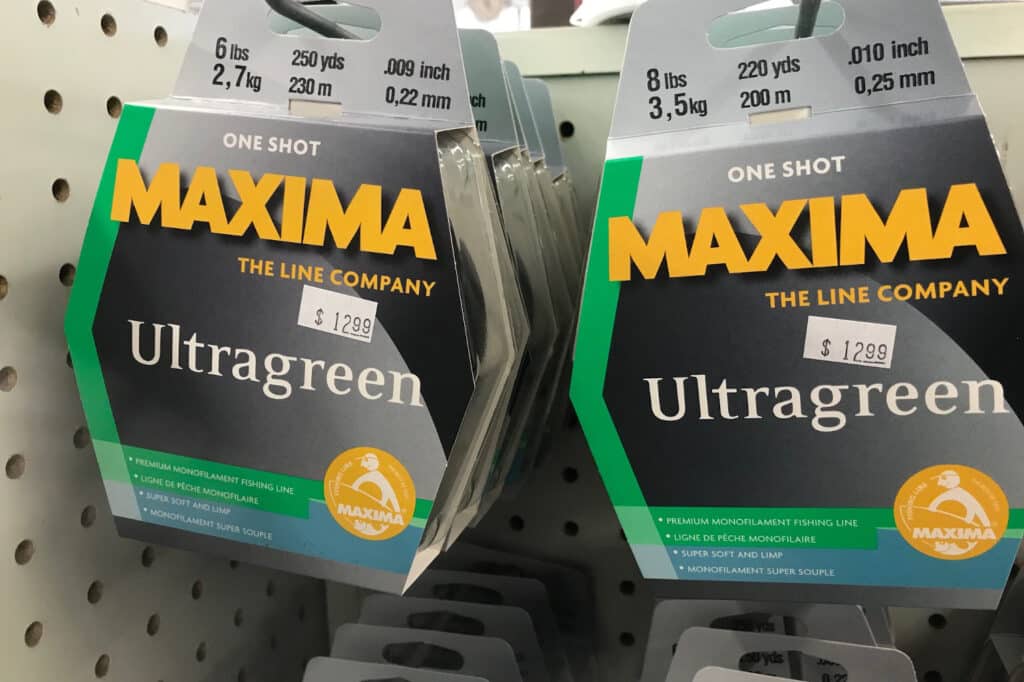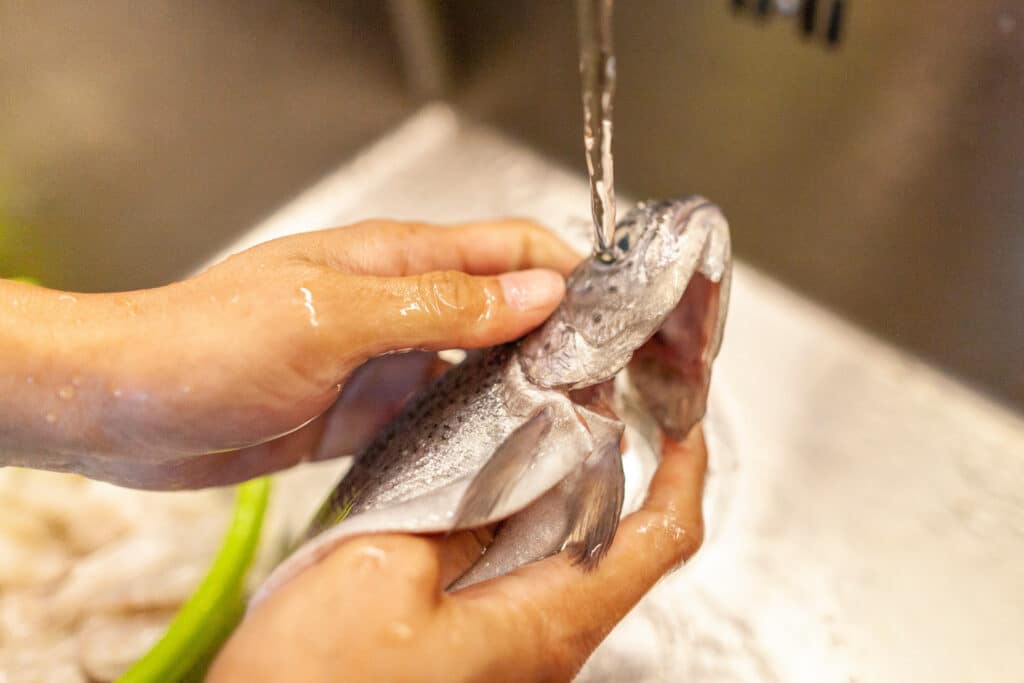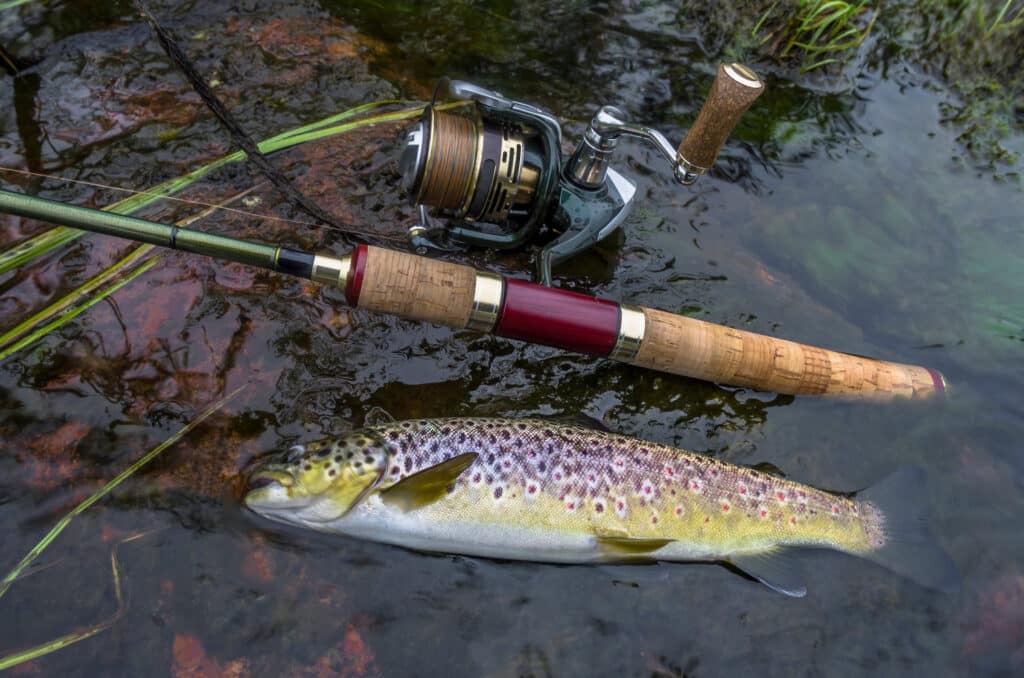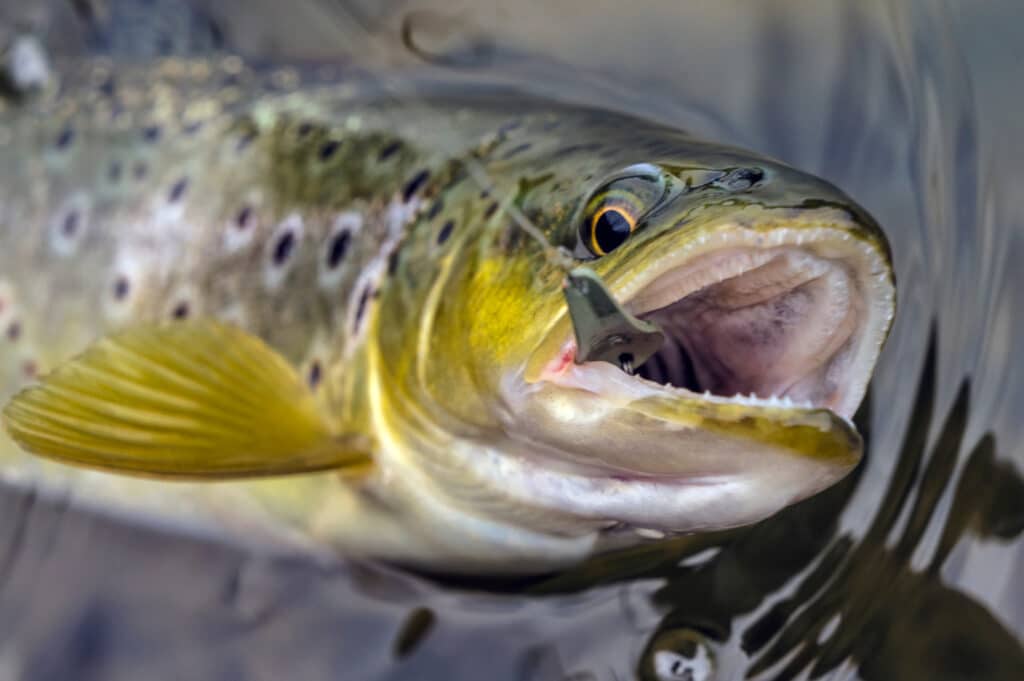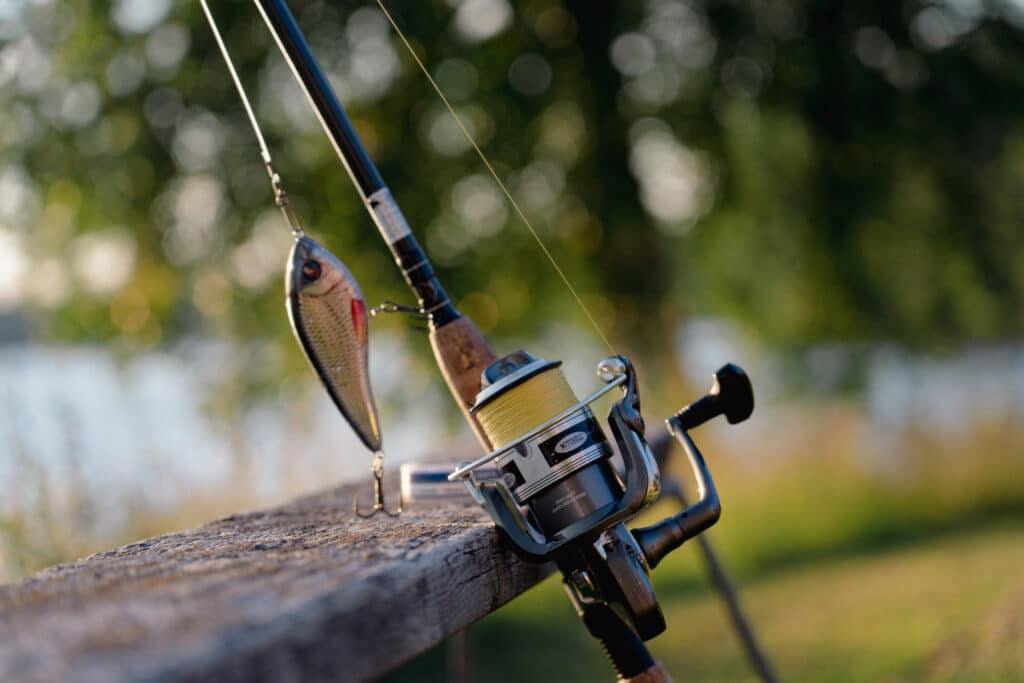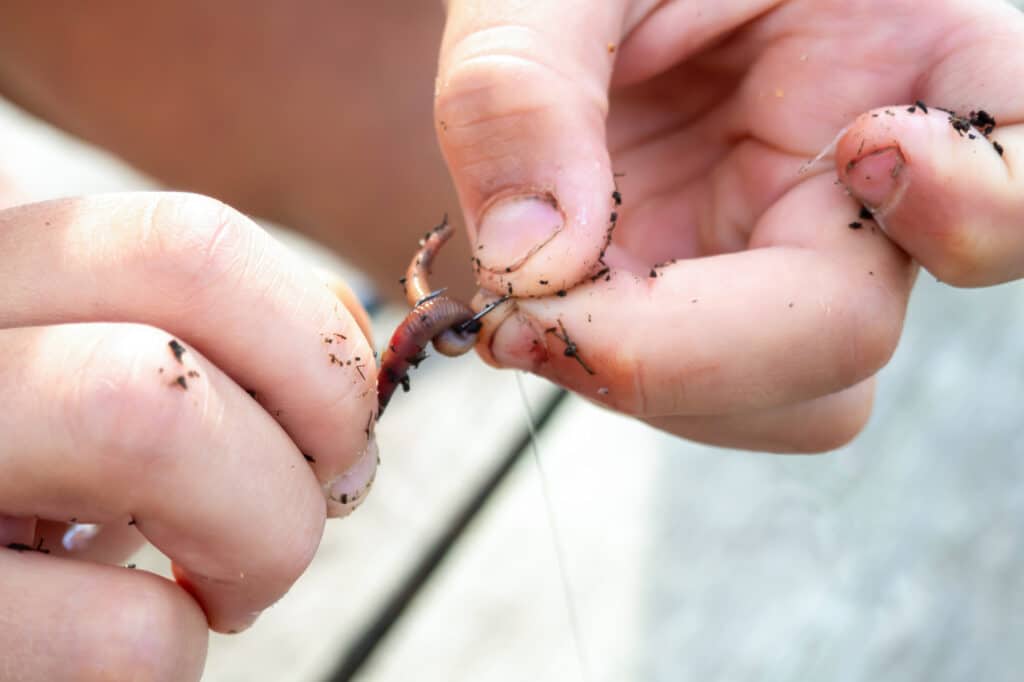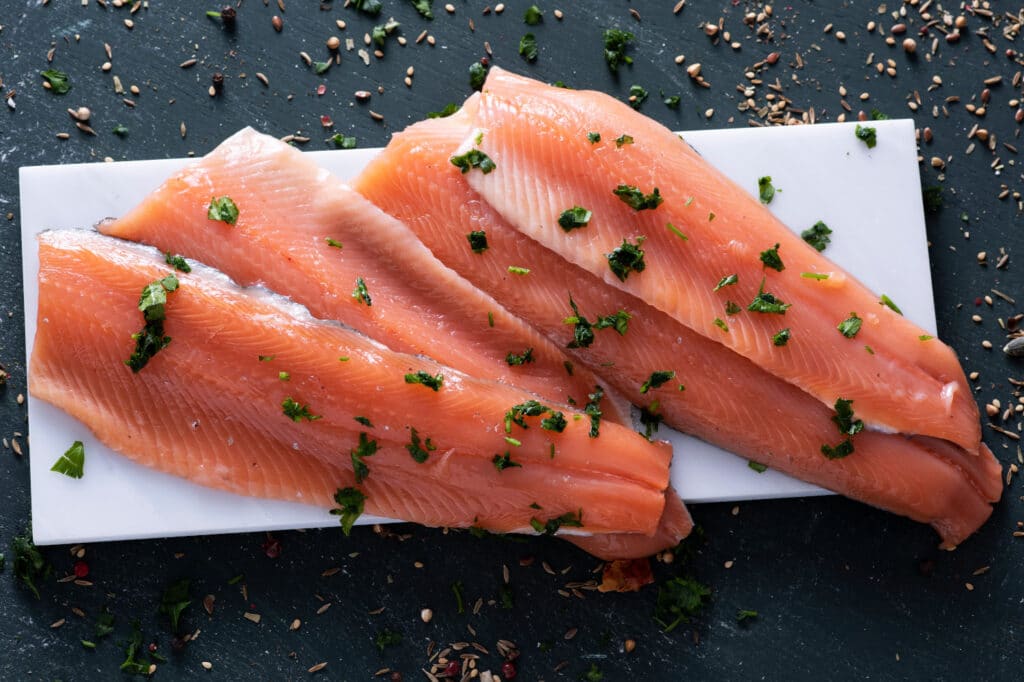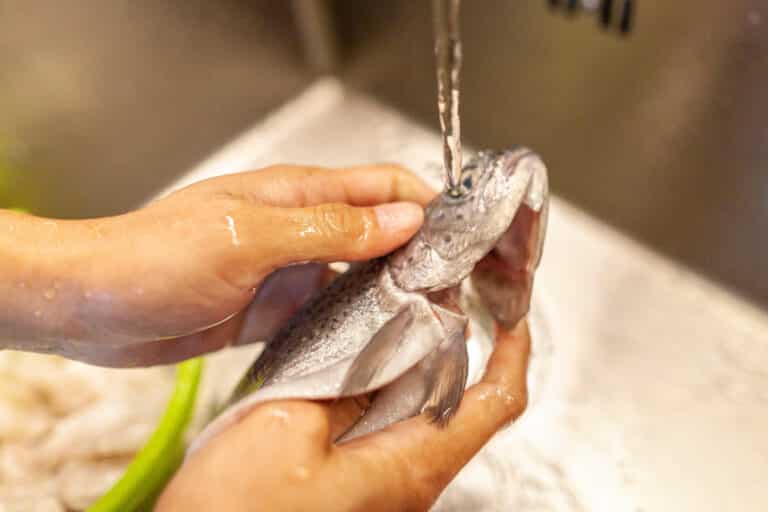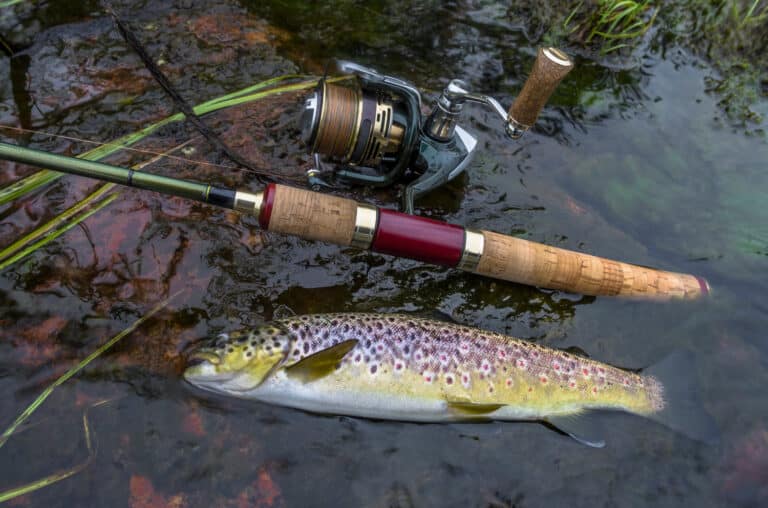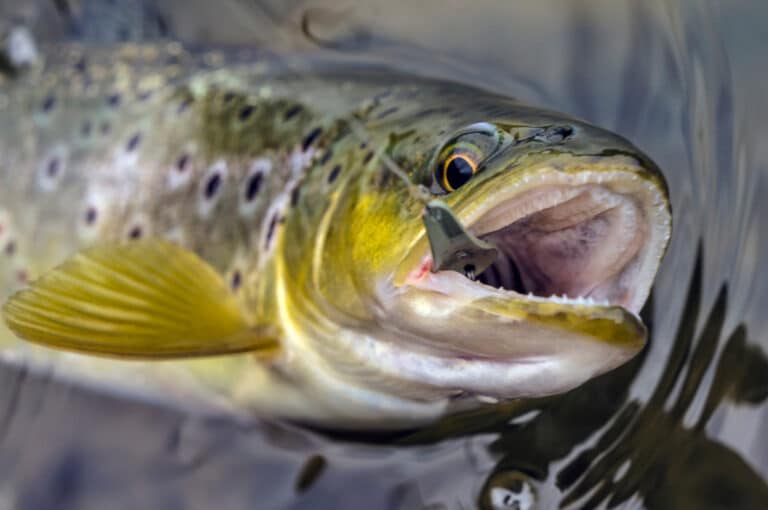Like anything in fishing, choosing the right fishing line for your situation can be overwhelming. Walk into Cabelas or Bass Pro Shops and you’ll have literally hundreds of options, each with different strengths and weaknesses. That makes it hard to nail down the best fishing line for trout in general, let alone a specific species.
Most of us (including me) don’t have enough time to read the reviews for every brand and line type every time we go into the tackle shop. Fortunately, I’ve fished for trout more than any other species, so I’ve spent a lot of time dialing in my line setup. After trying many different combinations, I’ve learned what I think makes the best fishing line for trout.
In this article, I’ll go over my favorite trout fishing line setups for both casting and trolling. I’ll also go over the pros and cons of each type of fishing line, as well as what situations each works best in. And by the time you finish reading this, you’ll have a good idea of what line you need to buy for trout fishing in your local lake or stream.
Came here for a quick answer? Here are my basic recommendations for casting and trolling lines.
- Casting: The best line test when casting for small to average-sized trout is 4 or 6-pound test fluorocarbon or monofilament line. If you’re after bigger trout, use 8-15 pound test.
- Trolling: When trolling for trout, use a 10-15 pound test main line (monofilament or braid) with a 6-8 pound test fluorocarbon or monofilament leader. (Again, if you’re expecting bigger trout, use 8-15 pound test).
I think overall, fluorocarbon is the best fishing line for trout. And if it’s up to me, I’ll almost always choose fluorocarbon lines over monofilament lines. These recommendations apply to most situations, but the best line will always vary depending on species, technique, and location. Read on to learn all about the different line types and their uses in trout fishing.
The Wild Provides is a participant in the Amazon Affiliate program. If you click through one of the links on this site and make a purchase, we may receive a small commission at no extra cost to you. It helps to keep us up and running, but all recommendations are my own honest opinions.
Trout: A Quick Overview
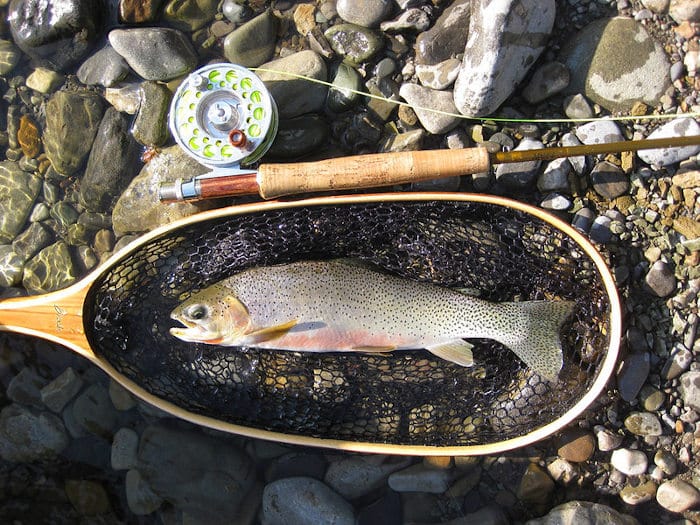
When deciding on the best fishing line for trout, it helps to know what species there are and how they differ. This will help you get a better idea of the types of line that will work best not only for trout in general, but also for your area.
Trout Species
There are several species of trout spread throughout North America. They vary in size and the type of water they live in, so you may want to adjust your line if you know what you’re fishing for. Here are the most commonly targeted species and their average sizes:
- Rainbow Trout: Rainbow trout are very widespread and live happily in many water conditions, from tiny streams to dirty city ponds. They are commonly caught in the 1-4 pound range (though the world record is 48lbs!).
- Cutthroat Trout: Cutthroat trout are found mostly in cold, clear rivers and mountain lakes. In the streams and rivers where they are most common, they are often caught in the 1-2 pound range.
- Brown Trout: Brown trout are not native to North America, but due to their size are highly sought after by anglers. They prefer cold, clear, waters (often rivers, though they can live in lakes a well), and 2-6 pound catches are common.
- Brook Trout: Though not actually a trout (brook trout are members of the char family), brook trout are common throughout much of North America. They prefer cold, clean water, and can regularly be found in small streams. They are usually small, reaching up to about 1 pound.
- Lake Trout: Also a member of the char family, lake trout live primarily in large lakes. They can grow to be extremely large, and catches of 15-30 pound fish aren’t uncommon.
The trout species vary a lot, but one thing that trout are known for is their wary-ness. They are sensitive to the visibility of line in the water, and if they can see it well, you’re probably going to catch fewer fish. You should generally use the lightest line you can get away with, and occasionally colored lines will work better than clear.
Another thing trout are known for is their tendency to fight hard. Big trout can go on long runs, so it’s important to be familiar with how to fight a fish if you’re going to use light line. If you aren’t familiar, slightly heavier line will be better for you.
What you can get away with depends on species and location though, which I’ll get into below. But first, a quick rundown of the three types of fishing line.
Types Of Fishing Line
I won’t go in-depth on the different types of fishing line in this article (I wrote a whole separate one for that). But I’ll quickly go over the three main types and how they relate to trout fishing specifically. Keep in mind that there isn’t any one “best” line for trout fishing.
There are three main types of fishing line: monofilament, fluorocarbon, and braid. Each has advantages and disadvantages, and I’ll go over each of them.
Monofilament Fishing Line
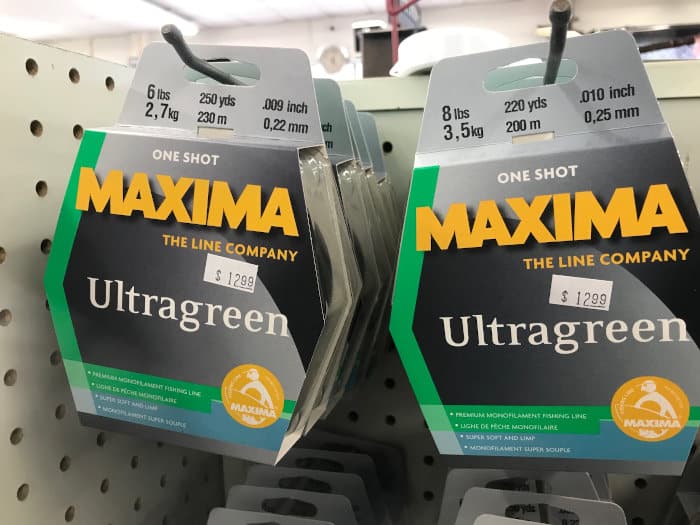
Monofilament is the classic fishing line. It’s very common and is generally the cheapest of the three types. It’s also easy to tie and has relatively high knot strength. The accessibility and ease of use of monofilament fishing lines make them very popular, and they work great for basic trout fishing.
Mono stretches more than the other types of line, so it’s more forgiving. You can fight fish that are bigger than its test rating, and it’s easy to spool and handle. This makes it ideal for beginners.
It does have some drawbacks, though. The biggest is that it has very low abrasion resistance, so when fishing areas with heavy cover it can break easily. Another issue is that at heavier line tests, it can be difficult to cast small spinners and lures.
I think mono is great for beginners. If you’re casting, the best line test for trout is line in the 4-6 pound range (unless you have reason to believe bigger fish are in your area). When trolling, start with 8-10 pound test line, or heavier if fishing for larger fish.
Braided Fishing line
Braided fishing line is widely used for many types of fish, but trout is not usually one of them. The reason for that is that braid is not translucent, so it’s extremely visible in clear water. This is especially apparent in cold, clear lakes and streams. It also has very low abrasion resistance, so it’s liable to break off if you get snagged.
Braid does have some advantages for trout anglers, though. It has zero stretch, so it offers the best sensitivity of any fishing line. This can be useful when using long lengths of line to get to where the fish are (like deep trolling or long casts).
It also has a smaller diameter (because of its higher tensile strength) and so it has less drag. This can be helpful when trolling without downriggers, as you’ll need less weight to get to the depth you want. It can also be helpful when casting longer distances on particularly windy days.
Though you can certainly catch trout with lures tied directly to braid, you should primarily use braided line as a main line when trolling for trout. You should only use it in combination with a monofilament or fluorocarbon leader, and 10-15 pound test will work well for most situations (though you should adjust for the size of the fish you expect; braid has no stretch, so it’s more likely to break off when pulled hard).
Fluorocarbon fishing Line
I’ll start with this: If I had to pick one, I think fluorocarbon is the overall best fishing line for trout.
Fluorocarbon fishing lines are like the best of both worlds. First of all, its low stretch provides much better sensitivity than mono, so you’ll be better able to detect light bites. It’s not quite as forgiving, but it does still have some stretch to it. The second is that it is highly abrasion resistant, so you’re less likely to break off than with mono.
The third and most important advantage is that it is virtually invisible in clear water. While mono tends to refract light, fluorocarbon line allows light to pass through it. This is perfect for stealthily presenting baits and lures to wary trout, and is why I use fluorocarbon as my go-to trout fishing line.
It does have its downsides though. Fluorocarbon line sinks much faster than mono, so when fishing baits under bobbers or any type of floating bait, mono can allow for more natural action in the water. Fluorocarbon spooled on a spinning reel can also be difficult for beginners because it has very low memory (but check out my post on the best fluoro options for spinning reels here). This means it’s more likely to unspool itself or get tangled on the cast. It also tends to be much more expensive than monofilament.
There is a way to have the benefits of fluorocarbon fishing line without the downsides, though. You can simply use mono (or braid) as your main line, and use fluorocarbon as a leader. I do this all the time, and it’s a great way to save money and avoid the drawbacks of fluoro.
Thoughts On Fluorocarbon Coated Line
There is a sub-section of fluoro (or mono, depending on how you look at it), called “fluorocarbon coated line”. This type of line is essentially mono with a fluorocarbon coating, and it’s designed to give you the best of both worlds. I will say that there are times when it’s an upgrade over fishing with straight mono, like when you need it to sink or be highly abrasion-resistant. But for most fishing applications, monofilament will cost less and work just as well.
If you’re considering using fluorocarbon-coated line to save some money over 100% fluorocarbon, just go with mono. It’ll work just fine as well.
Best Trout Line for Different Water Conditions
I have my general favorites, but sometimes while trout fishing, it makes sense to change up the line for water conditions. Trout can live in anything from extremely stained, cloudy water to crystal clear streams, and different fishing lines will perform better in different situations.
Best Fishing Line For Trout In Cloudy Water
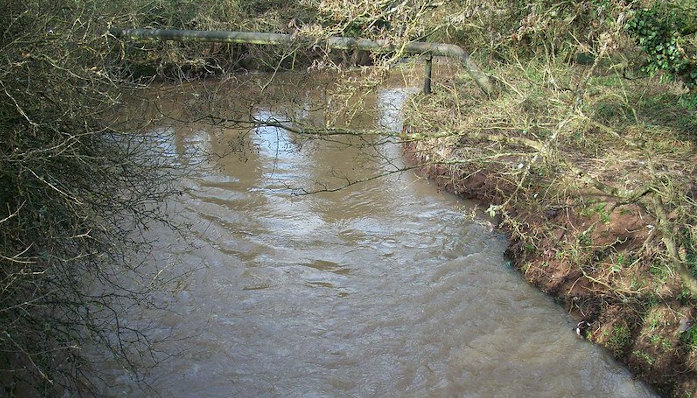
Trout may commonly live in clear streams and lakes, but rainbow trout especially can live just about anywhere. Stocked trout like rainbows often are put in stained, cloudy lakes and ponds, and fishing for trout in these conditions often calls for a change of line.
Clear mono or fluorocarbon will still work fine, but colored mono can work even better sometimes. It comes in various colors, but the best one is often translucent green. This blends better with the dirty water color and ultimately can mean catching more fish. Maxima Chameleon is also great for stained water, as its reddish-brown color blends perfectly with the water.
Monofilament comes in a variety of colors, so it doesn’t hurt to have a few on hand. That way you’ll be able to switch out leaders to match the color of the lake.
Best Fishing Line For Trout In Clear Water
The best trout fishing line for clear water is a pretty easy winner for me: it’s fluorocarbon.
As I described above, this is because fluorocarbon lines have the least visibility of any fishing line available. You can also use heavier line and still get a nearly invisible presentation, so it makes your line setup more versatile.
That said, if you’re fishing for trout in clear water but you don’t want your line to sink, then go with mono. Fluoro is just too dense for this application.
What Line Test Is Best For Each Trout Species?
This is a tough question. While some species, like brook trout, have a relatively small size range, others (like rainbows, lake trout, and brown trout) can be anywhere from 1 pound to 40! That makes it hard sometimes to decide what line weight to use.
The best recommendation here is to get to know your area. First, determine what species live there, and then determine how big they can get. You can check stocking records to get info on how big the average stocked trout is. That way you can figure out what line is best for trout in your local lake or river.
Aside from that, here are some quick recommendations on what line test is best to use for each trout species.
- Rainbow Trout: 2-6 pound test
- Lake Trout: 8-10 pound test
- Brown Trout: 8-10 pound test
- Brook Trout: 2-4 pound test
- Cutthroat Trout: 2-6 pound test
For really big trout, like trophy-sized browns or lakers, you may need to go even heavier. It all depends on your goal, but those who search specifically for these giant freshwater fish often use 10-20 lb braided line, tied to an 8-10 lb fluorocarbon leader.
Best Fishing Line: Top Picks
Here’s a list of my favorite fishing line for trout in each category. For each one, I’ve provided a best value option and a premium option, so if you’re working on a tight budget (like so many of us are) you can still get the best fishing line for your money.
Best Fluorocarbon Fishing Lines
Value Pick: Pline 100% Fluorocarbon
Pline Fluoro is a great value and an overall respectable combination of strength, softness, and abrasion resistance
Price: $18 for 250 yards of 6-lb test (check the current price on Amazon)
Premium Pick: Seaguar InvizX
Seaguar InvizX has super low memory compared to other fluorocarbon options, which makes it forgiving to cast and fish with. It’s also about the lowest visibility line you’ll find anywhere.
Price: $28 for 200 yards of 6-lb test (usually cheaper on Amazon)
Best Monofilament Fishing Lines
Value Pick: Berkely Trilene XT Mono
Berkeley XT is a great bang for the buck because its extra tough (the XT in the name), and casts smoothly.
Price: $9 for 330 yards of 6-lb test (check the current price on Amazon)
Premium Pick: Maxima Ultragreen
Maxima Ultragreen punches above it’s weight class in terms of strength, and if I had to pick one monofilament forever it would be Maxima. It’s also smooth casting and durable to boot.
Price: $15 for 110 yards of 6-lb test (check the price and variations on Amazon).
Best Braided Fishing Lines
Value Pick: PowerPro Spectra Fiber Braid
PowerPro is the braid mainstay. It’s a solid value, with great strength and abrasion resistance for the price.
Price: $18 for 150 yards of 10-lb test (check price on Amazon)
Premium Pick: Spiderwire Invisi-Braid Ultra-Braid
Spiderwire in general is super smooth-casting, and the Invisi-braid line is as low-vis as braid gets.
Price: $20 for 164 yards of 10-lb test (check price on Amazon)
Wrap Up
Overall, there isn’t one “best fishing line for trout” that’s always better than the rest. It all depends on your situation and the trout in your area. However, for a great combination of invisibility, strength, and sensitivity, fluorocarbon lines in the 4-8lb range are hard to beat. It’s what I almost always use for my leaders, and I recommend it to anyone who goes fishing for trout on a regular basis.
And once you’ve got your line dialed in, you’ll need some killer lures to go with it. Check out my post on the best trout lures for streams for my time-tested favorites.

